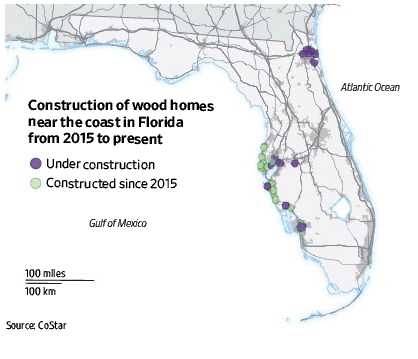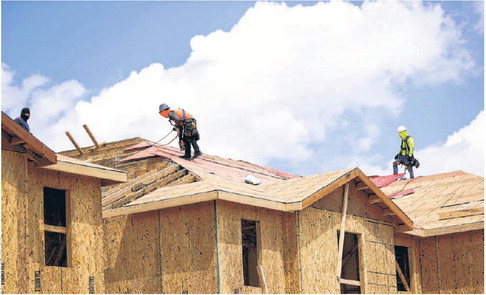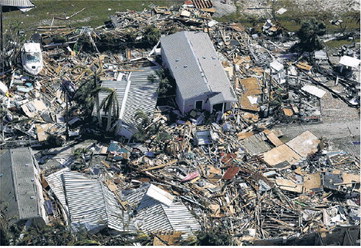Florida Home Builders Stick to Wood
The material is riskier than concrete in hurricanes but developers persist
BY DEBORAH ACOSTA - WSJ
Developers in Florida are rolling out new homes built with wooden frames, undaunted by the risk that wood can be less reliable than other materials for withstanding hurricane-force winds.
Homes with wooden frames are cheaper and faster to build than those framed in concrete, one reason why wood-frame construction is the norm in much of the U.S.
But most American homes are never tested by powerful storms as they often are in Florida. South Florida contractors phased out wood-frame construction after Hurricane Andrew’s 165-miles-per hour winds flattened communities built from the material in 1992. The state changed its building codes not long after that, and the share of wood-frame construction has declined dramatically in Florida over the past three decades.
Yet wood-frame construction is still permitted state-wide. It is even enjoying something of a revival in waterfront communities across Florida, including Jacksonville and Tampa.
New wood-framed cottages and apartment buildings are also rising in southwest Florida, after Hurricane Ian ripped through hundreds of wood-framed cottages there last year.
That storm killed 149 people in the third-costliest hurricane event in the country’s history.
At Fort Myers Beach, where wood cottages were ripped from their foundations and more than a dozen people died, developers are scooping up empty land. They are building new wood-framed single-family homes strapped onto concrete columns. Some are selling for more than $1 million.
Overall, nearly 1,700 apartment buildings in Florida are made of wood-frame construction, or about 8% of the state’s inventory, according to real-estate data firm CoStar Group. Thirteen buildings with wood frames and more than 3,700 units are under construction in the state.
Since 2015, more than two dozen such buildings have been built on or near the coasts, CoStar said.
At a time when labor and other costs associated with home construction have been rising, the cost savings offered by wood frames make them attractive.
A sharp decrease in lumber prices from a record in 2021, coupled with a much shorter build time, make wood an appealing option as waterfront
communities work to quickly rebuild after suffering the effects of a tropical storm.
Developers of wood-framed homes say this construction is considerably sturdier than before.
The new building code added provisions that require stronger connections between the wood planks, and homes must have hurricane-proof windows.
Wood frames also can be built to withstand hurricane-force winds, according to architects and structural engineers.
But there is little room for error. Most engineers agree that concrete construction offers the strongest assurances of withstanding powerful winds. The slightest flaw in the design or construction of a wood-framed house and the building could collapse under the force of a violent storm, engineers say.
“If you connect it properly, it is strong,” said Anne Cope, the chief engineer for the Insurance Institute for Business and Home Safety, of wood-framed structures. “If you don’t, it’s simply a house of cards.”
Wood-framed structures also are more susceptible to water intrusion and termites than concrete, both of which can weaken the structure.
“You might end up with a structure that is weaker because of conditions you did not even know about,” said Felix X. Rodriguez, a construction attorney at Bilzin Sumberg, based in South Florida.
Insurance costs, meanwhile, have boosted the price of building with wood. Premiums have skyrocketed across the state, and in particular for wood-frame structures. But because of the low cost of lumberand shorter time frame for construction, wood

![]()

![]()
Builders say less-costly wood-frame homes can be built to withstand the hurricane-force winds Florida sometimes sees. OCTAVIO JONES/ REUTERS

![]()
Hurricane Ian wrecked hundreds of wood-framed cottages in southwest Florida last year. JOE RAEDLE/ GETTY IMAGES
homes are still usually cheaper to build.
One of the biggest wood-framed projects under way began construction this year on the water near Tampa Bay. Mid-America Apartment Communities is building a 495-unit wood-frame apartment complex with a wood frame on top of a concrete parking podium.
In a sign of how hard it can be to finance wood-framed developments, Mid-America is self-funding the project and forgoing pricey hurricane insurance to make it happen.
Mohamed Elzeini, a project engineer at CBG Building Company, the contractor building the property, said the complex “is as extreme as you can find in wood construction. It’s like six stories and right on the water. Wind speed is going to be very, very high up there.”
But, he added, it is up to code.
Mid-America didn’t respond to requests for comment.
A similar project across the street has been unable to get the funding needed to move forward, Elzeini said, because no company will insure it.
In Mexico Beach on Florida’s panhandle, a Category 5 storm devastated the community in 2018 with winds of more than 160 mph.
The code in that part of Florida requires buildings to stand up to winds of only 140 mph and doesn’t have the “high wind velocity zone” designation. Efforts to create a more stringent building code there have failed.
“I think it’s a mistake to build stick on the coast,” said Dan Kodsi, a developer who builds wood-frame apartment complexes in Orlando.